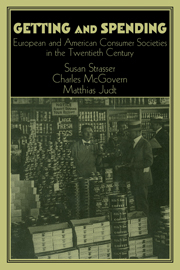Book contents
- Frontmatter
- Introduction
- Part One Politics, Markets, and the State
- 1 The Consumers' White Label Campaign of the National Consumers' League, 1898-1918
- 2 Consumption and Citizenship in the United States, 1900-1940
- 3 Changing Consumption Regimes in Europe, 1930-1970: Comparative Perspectives on the Distribution Problem
- 4 Customer Research as Public Relations: General Motors in the 1930s
- 5 The New Deal State and the Making of Citizen Consumers
- 6 Consumer Spending as State Project: Yesterday's Solutions and Today's Problems
- 7 The Emigré as Celebrant of American Consumer Culture: George Katona and Ernest Dichter
- 8 Dissolution of the “Dictatorship over Needs”?: Consumer Behavior and Economic Reform in East Germany in the 1960s
- Part Two Everyday Life
- Part Three History and Theory
- Index
6 - Consumer Spending as State Project: Yesterday's Solutions and Today's Problems
Published online by Cambridge University Press: 05 January 2013
- Frontmatter
- Introduction
- Part One Politics, Markets, and the State
- 1 The Consumers' White Label Campaign of the National Consumers' League, 1898-1918
- 2 Consumption and Citizenship in the United States, 1900-1940
- 3 Changing Consumption Regimes in Europe, 1930-1970: Comparative Perspectives on the Distribution Problem
- 4 Customer Research as Public Relations: General Motors in the 1930s
- 5 The New Deal State and the Making of Citizen Consumers
- 6 Consumer Spending as State Project: Yesterday's Solutions and Today's Problems
- 7 The Emigré as Celebrant of American Consumer Culture: George Katona and Ernest Dichter
- 8 Dissolution of the “Dictatorship over Needs”?: Consumer Behavior and Economic Reform in East Germany in the 1960s
- Part Two Everyday Life
- Part Three History and Theory
- Index
Summary
As we approach the end of the twentieth century, “socialist” states have disappeared and been replaced by governments based on market capitalism. Formerly antiimperialist and anticolonialist leaders in Asia, Africa, and Latin America compete with each other to make concessions to the International Monetary Fund and the World Bank in order to secure outside investment. The active oppositional movements of the 1960s no longer exist; mass protest and grass roots organizing no longer threaten the immediate interests of the powerful in any meaningful way. Trade unions in advanced capitalist countries have suffered sharp declines in membership and have systematically surrendered the gains they had made by midcentury.
Neoconservatives have secured control of state policy everywhere. They have cut state spending on education, health, and welfare; privatized public enterprises; liberalized trade; devalued currency; restricted credit; lowered wages; and eliminated significant areas of business regulation. For years, we have been told that all of these measures were necessary to bring about economic growth, social stability, and cultural unity. But what has actually taken place instead?
Lower wages and reduced public spending have led to less buying power, increased unemployment, unendurable debt, and economic austerity. During the social democratic era from 1948 to 1973, global gross national product (GNP) grew by almost 5 percent every year. But with the emergence of neoconservative policies between 1974 and 1989, it grew at only half the rate of the previous period. Since 1989, growth has been even slower.
- Type
- Chapter
- Information
- Getting and SpendingEuropean and American Consumer Societies in the Twentieth Century, pp. 127 - 148Publisher: Cambridge University PressPrint publication year: 1998
- 15
- Cited by



